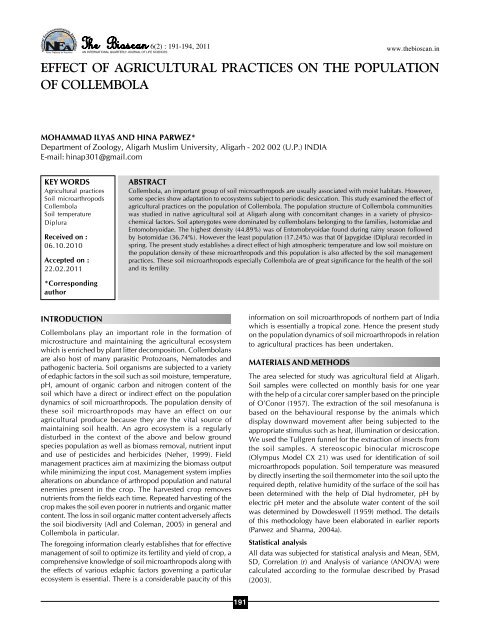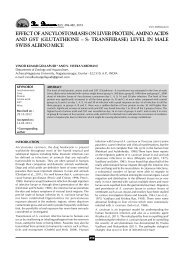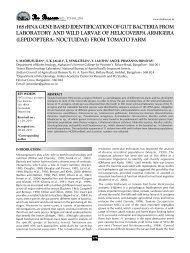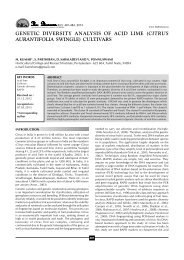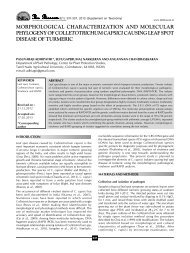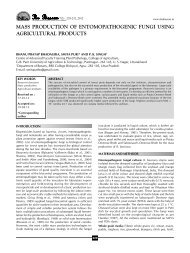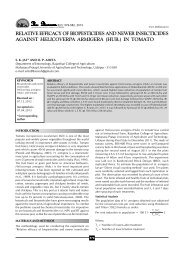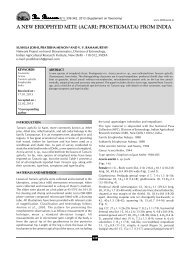full paper - THE BIOSCAN
full paper - THE BIOSCAN
full paper - THE BIOSCAN
Create successful ePaper yourself
Turn your PDF publications into a flip-book with our unique Google optimized e-Paper software.
NSave Nature to Survive<br />
6(2) : 191-194, 2011 www.thebioscan.in<br />
EFFECT OF AGRICULTURAL PRACTICES ON <strong>THE</strong> POPULATION<br />
OF COLLEMBOLA<br />
MOHAMMAD ILYAS AND HINA PARWEZ*<br />
Department of Zoology, Aligarh Muslim University, Aligarh - 202 002 (U.P.) INDIA<br />
E-mail: hinap301@gmail.com<br />
KEY WORDS<br />
Agricultural practices<br />
Soil microarthropods<br />
Collembola<br />
Soil temperature<br />
Diplura<br />
Received on :<br />
06.10.2010<br />
Accepted on :<br />
22.02.2011<br />
*Corresponding<br />
author<br />
INTRODUCTION<br />
ABSTRACT<br />
Collembola, an important group of soil microarthropods are usually associated with moist habitats. However,<br />
some species show adaptation to ecosystems subject to periodic desiccation. This study examined the effect of<br />
agricultural practices on the population of Collembola. The population structure of Collembola communities<br />
was studied in native agricultural soil at Aligarh along with concomitant changes in a variety of physicochemical<br />
factors. Soil apterygotes were dominated by collembolans belonging to the families, Isotomidae and<br />
Entomobryoidae. The highest density (44.89%) was of Entomobryoidae found during rainy season followed<br />
by Isotomidae (36.74%). However the least population (17.24%) was that 0f Japygidae (Diplura) recorded in<br />
spring. The present study establishes a direct effect of high atmospheric temperature and low soil moisture on<br />
the population density of these microarthropods and this population is also affected by the soil management<br />
practices. These soil microarthropods especially Collembola are of great significance for the health of the soil<br />
and its fertility<br />
Collembolans play an important role in the formation of<br />
microstructure and maintaining the agricultural ecosystem<br />
which is enriched by plant litter decomposition. Collembolans<br />
are also host of many parasitic Protozoans, Nematodes and<br />
pathogenic bacteria. Soil organisms are subjected to a variety<br />
of edaphic factors in the soil such as soil moisture, temperature,<br />
pH, amount of organic carbon and nitrogen content of the<br />
soil which have a direct or indirect effect on the population<br />
dynamics of soil microarthropods. The population density of<br />
these soil microarthropods may have an effect on our<br />
agricultural produce because they are the vital source of<br />
maintaining soil health. An agro ecosystem is a regularly<br />
disturbed in the context of the above and below ground<br />
species population as well as biomass removal, nutrient input<br />
and use of pesticides and herbicides (Neher, 1999). Field<br />
management practices aim at maximizing the biomass output<br />
while minimizing the input cost. Management system implies<br />
alterations on abundance of arthropod population and natural<br />
enemies present in the crop. The harvested crop removes<br />
nutrients from the fields each time. Repeated harvesting of the<br />
crop makes the soil even poorer in nutrients and organic matter<br />
content. The loss in soil organic matter content adversely affects<br />
the soil biodiversity (Adl and Coleman, 2005) in general and<br />
Collembola in particular.<br />
The foregoing information clearly establishes that for effective<br />
management of soil to optimize its fertility and yield of crop, a<br />
comprehensive knowledge of soil microarthropods along with<br />
the effects of various edaphic factors governing a particular<br />
ecosystem is essential. There is a considerable paucity of this<br />
191<br />
information on soil microarthropods of northern part of India<br />
which is essentially a tropical zone. Hence the present study<br />
on the population dynamics of soil microarthropods in relation<br />
to agricultural practices has been undertaken.<br />
MATERIALS AND METHODS<br />
The area selected for study was agricultural field at Aligarh.<br />
Soil samples were collected on monthly basis for one year<br />
with the help of a circular corer sampler based on the principle<br />
of O’Conor (1957). The extraction of the soil mesofanuna is<br />
based on the behavioural response by the animals which<br />
display downward movement after being subjected to the<br />
appropriate stimulus such as heat, illumination or desiccation.<br />
We used the Tullgren funnel for the extraction of insects from<br />
the soil samples. A stereoscopic binocular microscope<br />
(Olympus Model CX 21) was used for identification of soil<br />
microarthropods population. Soil temperature was measured<br />
by directly inserting the soil thermometer into the soil upto the<br />
required depth, relative humidity of the surface of the soil has<br />
been determined with the help of Dial hydrometer, pH by<br />
electric pH meter and the absolute water content of the soil<br />
was determined by Dowdeswell (1959) method. The details<br />
of this methodology have been elaborated in earlier reports<br />
(Parwez and Sharma, 2004a).<br />
Statistical analysis<br />
All data was subjected for statistical analysis and Mean, SEM,<br />
SD, Correlation (r) and Analysis of variance (ANOVA) were<br />
calculated according to the formulae described by Prasad<br />
(2003).
MOHAMMAD ILYAS AND HINA PARWEZ<br />
RESULTS AND DISCUSSION<br />
The data for seasonal variation in soil edaphic factors is shown<br />
in Table 1. Moisture content of the soil ranges between 4.98 -<br />
19.39%, the lowest in May and the highest in September,<br />
whereas the soil temperature was recorded as high as 32ºC in<br />
the month of May and the lowest (18.5ºC) during December.<br />
The total number of soil insects especially apterygote insects<br />
collected from the soil samples showed fluctuations<br />
corresponding with monsoon peak and a winter low<br />
consistently (Table 2). The apterygote insect population was<br />
represented by order-Collembola and order-Diplura.<br />
Collembolans being the major group of the sub soil community<br />
were found in dominant number. They are represented by<br />
members of family Poduridae, Isotomidae, Onychiuridae,<br />
Nenuridae, and Entomobryoidae. Entomobrya sp was highest<br />
in number along with other representatives collected in<br />
different proportions showed a monsoon peak and a summer<br />
minima. Diplurans, the other apterygote insects were also<br />
collected but their population was meagre and represented<br />
only by Japyx sp. (Fig. 2). Similarly, Parwez and Sharma (2004b)<br />
observed that the order Diplura represented by Japyx sp<br />
showed an increase in population during wet months (July-<br />
September) coinciding with the peak of abundance of<br />
collembolans. The simple correlation coefficient between the<br />
apterygote insects mainly Collembola and Diplura with<br />
different physico chemical parameters such as temperature<br />
and moisture revealed that the variation of the insectan<br />
population were significant at p < 0.05 level (Table 3).<br />
192<br />
The results presented in this study are based on the survey of<br />
soil samples collected from an agricultural field which is under<br />
frequent tillage. The tillage and manuring of the area would<br />
disturb the soil profile. The site under study was utilized<br />
throughout the year by different crops. In the month of February<br />
sowing of Luffa crop is done which is harvested by the end of<br />
August. After this the field is ploughed and Mustard seeds are<br />
sown which is harvested at the end of January or February but<br />
before March. The agricultural intensification through crop<br />
rotation is only to overcome the insufficient food production<br />
for the needs of an expanding population. The outcome in<br />
terms of food production may be positive but maintenance of<br />
decomposer communities is very essential. The farmers have<br />
used chemical fertilizer for sustaining and improving the fertility<br />
of the soil. The changing land use and agricultural<br />
intensification has a profound effect on the structure and<br />
diversity of decomposer community (Beare et al., 1997).<br />
Further the impact of tillage that is when the field experienced<br />
heavy ploughing, has a direct effect on the soil profile as well<br />
as on the population of insects. Before sowing and after<br />
harvesting, the area is ploughed or tilled which turns the whole<br />
soil profile upside down and it was during this period that we<br />
observed low population of collembolans and very low of<br />
diplurans. This temporary decline in the population during<br />
March and April could be explained partly due to the effects<br />
of herbicide and insecticide and manual tilling of the soil<br />
(Choi et al., 2006). When the fields become lush green with<br />
vegetation, the population of microarthropods showed an<br />
increasing trend despite the fact that fields are tilled and the<br />
Table 1: Seasonal variations in edaphic factors in an agricultural soil at Aligarh (U.P.), India<br />
Months →<br />
Edaphic Factors ↓<br />
Jan Feb Mar Apr May Jun Jul Aug Sep Oct Nov Dec<br />
Temperature ( OC) 20 21 22 31 32 32 28 31 29 27 23 18.5<br />
Moisture (%) 7.96 6.34 5.17 5.10 4.98 5.02 19.39 14.13 15.04 18.05 10.42 8.10<br />
Relative humidity (%) 55 46 34 42 36 36 95 70 66 45 81 52<br />
pH 7.8 7.5 7.4 7.4 7.5 7.7 7.6 7.6 7.5 7.4 7.7 7.6<br />
Table2: Total population and density of Collembola in an agricultural land at Aligarh<br />
Family↓ Months → Jan Feb Mar Apr May Jun Jul Aug Sep Oct Nov Dec Total Average<br />
Isotomidae Population 27 35 40 42 46 50 57 70 78 49 36 28 558.00<br />
Density 6.75 8.75 10.00 10.52 11.50 12.50 14.25 17.50 19.50 12.25 9.00 7.00 11.625<br />
Entomobryoidae Population 10 12 15 20 47 56 68 72 80 50 40 20 490.00<br />
Density 2.50 3.00 3.75 5.00 11.75 14.00 17.00 18.00 20.00 12.50 10.00 5.00 10.208<br />
Poduridae Population 8 30 28 20 15 12 30 40 40 55 30 27 335<br />
Density 2.00 7.50 7.00 5.00 3.75 3.00 7.50 10.00 10.00 13.75 7.50 6.75 6.979<br />
Onychiuridae Population 10 15 20 25 28 30 28 20 29 20 22 15 262<br />
Density 2.50 3.75 5.00 6.25 7.00 7.50 7.00 5.00 7.25 5.00 5.50 3.75 5.458<br />
Nenuridae Population 25 32 35 30 12 15 60 55 50 30 27 25 398<br />
Density 6.25 8.00 8.75 7.50 3.00 3.75 15.00 13.75 12.5 7.50 6.75 6.25 8.271<br />
Diplura / Japygidae Population 2 1 2 3 2 1 3 4 2 3 4 2 29<br />
Density 0.50 0.25 0.50 0.75 0.50 0.25 0.75 1.00 0.50 0.75 1.00 0.50 0.604<br />
Table 3: Correlation between different apterygote populations with edaphic factors during the year<br />
Order Collembola Collembola Collembola Collembola Collembola Diplura<br />
(Family)→<br />
Variables↓<br />
(Poduridae) (Isotomidae) (Onychiuridae) (Nenuridae) (Entomobryoidae) (Japygidae)<br />
Soil Temperature 0.90 0.97 0.99 0.90 0.90 0.92<br />
Moisture 0.90 0.92 0.87 0.94 0.92 0.91<br />
All values were significant at p
Physical factors<br />
Population<br />
140<br />
120<br />
100<br />
80<br />
60<br />
40<br />
20<br />
0<br />
90<br />
80<br />
70<br />
60<br />
50<br />
40<br />
30<br />
20<br />
10<br />
0<br />
Jan.<br />
Family-Poduridae (OC) Family- Isotomidae (OC) Family- Onychiuridae (OC)<br />
s<br />
Family-Nenuridae (OC) Family-Entomobryoide OC) Family-Japygidae (OD)<br />
Feb.<br />
R elative hum idity (% ) Temperature Tempe rature (ºC)<br />
(°C) Rainfall (mm)<br />
Jan Feb Mar Apr May Jun Jul Aug Sep Oct Nov Dec<br />
Months<br />
Figure 1: Climatological data of Aligarh during the period of present<br />
investigation<br />
Mar.<br />
Apr.<br />
May<br />
June<br />
Months<br />
Figure 2: Mean value of insectan population of mineral soil up to a<br />
depth of 5 cm; OC = Order-Collembola, OD = Order-Diplura<br />
cash crop is rotated throughout the year.<br />
In the present study we also observed that various groups of<br />
collembolans have shown different moisture preferences.<br />
Members belonging to family Isotomidae showed highest<br />
population profile throughout the year from January to<br />
December whereas members of Poduridae family remained<br />
lowest all through. The population of members of other groups<br />
of collembolans remained confined between these two groups.<br />
The reason for such varied population density could be<br />
attributed to treatments given to the soil during different<br />
cropping and harvesting periods which may directly affect<br />
the soil water content, soil temperature and also the diversity<br />
of soil microarthropods (Maria et al., 2004). The soil moisture<br />
plays a vital role in maintaining the population of<br />
microarthropods with an increase in monsoon months.<br />
During monsoon months due to heavy rains, we observed<br />
low pH (7.4) in the soil and increased atmospheric humidity.<br />
The soil pH is an important edaphic factor for the well being<br />
of communities of soil organisms. The pH is also affected by<br />
the pollutants added up in the soil along with rain water (Jaeger<br />
and Eisenbeis, 1984). Soil pH also influences the fecundity<br />
and longevity of Collembola (Hutson, 1978). The longevity<br />
was highest at pH 4 – 6, egg production maximum at pH 7.2<br />
and optimum fecundity was at pH 5.2. These observations<br />
fall in line as when pH was low (7.4) the population density<br />
was 35.<br />
During this study, we observed an increase in the population<br />
of collembolans during monsoon months and their decline<br />
during hot summer and extreme winter months. Heavy rains<br />
which increase the moisture content of the soil (Fig. 1) and<br />
decrease in the soil temperature, this condition to some extent<br />
July<br />
Aug.<br />
Sept.<br />
Oct.<br />
Nov.<br />
Dec.<br />
193<br />
COLLEMBOLAN POPULATION AND AGRICULTURAL PRACTICES<br />
have a direct effect on the population of soil microarthropods.<br />
These observations fall in line with that of Huhta and Hanninen<br />
(2001) that varying moisture contents affect the population of<br />
collembolans. The densities of collembolan species were higher<br />
in wet soil than in dry soil. The effect of soil moisture was also<br />
studied as the population of Collembola which was low in pre<br />
monsoon months May (4.98%) and high (19.39%) in post<br />
monsoon month (July). It was observed that soil moisture is a<br />
major limiting factor on vertical distribution of the Collembola.<br />
Temperature plays an important role in seasonal variation of<br />
these microarthropods specially collembolans and diplurans<br />
which had also been reported earlier by Sinha et al., (1988).<br />
We observed a low population of Collembola in winter that<br />
corresponded well with consistent decrease in soil and<br />
atmospheric temperature (18.5ºC and 12ºC). The reason for<br />
this low population of Collembola at low temperature could<br />
be that during low soil temperature, the moisture content of<br />
the soil is also very less (20ºC, 4.98%) which is unfavourable<br />
since soil microarthropods flourish well in moist conditions.<br />
In dry and desiccated soil the fungal growth is negligible and<br />
fungus being the main food of the collembolans, their<br />
population show a declining trend during this period. Yet<br />
another reason of low collembolan population at low<br />
temperature could be that the arrest in reproduction and higher<br />
adult mortality. It has also been observed that many<br />
collembolans species undergo hibernation (Joose, 1981).<br />
Earlier Christiansen (1964) have reported that temperature<br />
regulates the reproduction of springtails but the role of moisture<br />
is equally important in regulating and synchronizing the<br />
reproductive activity, hatching and mortality. According to<br />
Parwez and Sharma (2004c) the temperature and moisture<br />
content play a significant role in the regulating of population<br />
density of soil mesofauna. This is likely to be linked with the<br />
reproductive activities of this group of organisms. Similarly<br />
Collembola may be influenced by the occurrence of long dry<br />
spell during hot summer months because they are prone to<br />
desiccation (Parwez and Sharma, 2004a). Some of the<br />
collembolans have become adapted to periodically dry<br />
environment. To avoid summer drought, the collembolans<br />
have adopted certain strategies such as a primitive tracheal<br />
system and a thick integument and also aestivation (Alvarez et<br />
al., 1999). Therefore in hot summer months, when the<br />
atmospheric temperature was very high and humidity was low<br />
and the soil temperature was also very high, the collembolan<br />
population was affected. The optimum temperature preference<br />
for these collembolans to grow and survive is 30ºC (Ashraf,<br />
1971). Parwez and Sharma (2004d) observed that the<br />
collembolan populations showed a negative correlation with<br />
soil temperature and a positive one with soil moisture which is<br />
also supported by our study since there is a decline in<br />
population in hot months when atmospheric temperature was<br />
more than 45ºC. The collembolan population showed a<br />
negative correlation with soil temperature (Bandhopadhay et<br />
al., 2002). In conclusion, it may be stated that the present<br />
study has clearly established that soil management practices<br />
such as rotation of crop, tillage, ploughing, application of<br />
fertilizers and pesticides have profound effect on the overall<br />
population dynamics of collembolans. This important group<br />
of soil microarthropods is also affected by variety of edaphic<br />
factors namely, atmospheric and soil temperature, humidity,
MOHAMMAD ILYAS AND HINA PARWEZ<br />
soil moisture content and pH which are independently<br />
correlated with collembolan population.<br />
ACKNOWLEDGEMENTS<br />
The authors are grateful to Chairman, Department of Zoology,<br />
AMU, Aligarh for providing necessary research facilities. This<br />
work has been supported by the research grant no. 34-423/<br />
2008 (SR) sanctioned by University Grants Commission, New<br />
Delhi.<br />
REFERENCES<br />
Adl, M. S. and Coleman, D. C. 2005. Dynamics of soil protozoa<br />
using a direct count method. Biology and Fertility of Soil. 168-171.<br />
Alvarez, T., Frampton, G. K. and Goulson, D. 1999. The effects of<br />
drought upon epigeal Collembola from arable soils. Agricultural and<br />
Forest Entomology. 1: 243-248.<br />
Ashraf, M. 1971. Influences of environmental factors on Collembola.<br />
Rev. Ecol. Biol. Sol. 8: 243-252.<br />
Bandhyopadhyaya, I., Choudhari, D. K. and Ponge, J. F. 2002. Effects<br />
of some physical factors and agricultural practices on Collembola in<br />
a multiple cropping programme in West Bengal (India). European J.<br />
Soil Biology. 38: 111-117.<br />
Beare, M. H., Reddy, M. V. T. and Srivastava, S. C. 1997. Agricultural<br />
intensification, Soil Biodiversity and agroecosystem function in the tropics:<br />
The role of decomposer biota. Applied Soil Ecology. 6(1): 87-108.<br />
Christiansen, K. 1964. Bionomic of Collembola. Ann. Rev. Entomol.<br />
9: 147-178.<br />
Choi, W. I., Moorhead, D. L., Neher, D. A. and Ryoo, M. I. 2006.<br />
Study of soil temperature and moisture effects on population dynamics<br />
of Paronychiurus kimi (Collembola: Onychiuridae). Biology and<br />
Fertility of Soil. 43(1): 69-75.<br />
Dowdeswell, W. H. 1959. Practical Animal Ecology. Methuen and<br />
Co. Ltd., London.<br />
Huhta, V. and Hanninen, S. M. 2001. Effects of temperature and<br />
194<br />
moisture fluctuations on an experimental soil microarthropod<br />
community. Pedobiologia. 45(3): 279-286.<br />
Hutson, B. R. 1978. Influence of pH, temperature and salinity on the<br />
fecundity and longevity of four species of Collembola. Pedobiologia.<br />
18: 163-179.<br />
Jaeger, G. and Eisenbeis, G. 1984. pH-depended absorption of<br />
solution by the ventral tube of Tomocerus flavescens (Tullberg, 1871)<br />
(Insecta, Collembola). Rev. Ecol. Sol. 21: 519-531.<br />
Joose, E. N. G. 1981. Ecological strategies and population regulation<br />
of Collembola in heterogeneous environment. Pedobiologia. 21(5):<br />
345-356.<br />
Maria, A. T., Athanasios, S. K., Eleni, K., George, P. S. and Stefanes,<br />
P. S. 2004. Responses of soil microarthropods to experimental shortterm<br />
manipulations of soil moisture. Applied Soil Ecology. 29(1): 17-<br />
26.<br />
Neher, D. A. 1999. Soil community composition and ecosystem<br />
processes: comparing agricultural ecosystems with natural ecosystems.<br />
Agrofor. Syst. 45: 159 185.<br />
O’Conor, F. B. 1957. An ecological study of the enchytracid worm<br />
population in a coniferous forest soil. Oikos 8: 161-199.<br />
Parwez, H. and Sharma, M. K. 2004 a. Seasonal fluctuation in the<br />
population density of soil insects under Acacia Plantation. Annals of<br />
Biology. 20(2): 115-122.<br />
Parwez, H. and Sharma, M. K. 2004 b. Species diversity and population<br />
dynamics in the soil Mesofauna of arable land. Annals of Biology.<br />
20(2): 123-130.<br />
Parwez, H. and Sharma, M. K. 2004c. Circanual variations and<br />
interrelationship of abiotic factors with the soil dwelling mesofauna<br />
in a fallow land. Bulletin Pure and Applied Sciences. 23A(1): 35-40.<br />
Parwez, H. and Sharma, M. K. 2004d. Dynamics of the collembolan<br />
population in two different ecotypes in a tropical reson. Bio-Science<br />
Research Bulletin. 20(1): 27-38.<br />
Prasad, S. 2003. Elements of Biostatistics. Rastogi Publications.<br />
Sinha, P. B., Sen, N. S. and Jafri, H. A. 1988. On the seasonal<br />
population fluctuation of Collembola and Acarina in deciduous forest<br />
at Ranchi. J. Environ. Biol. 9(1): 79-83.


